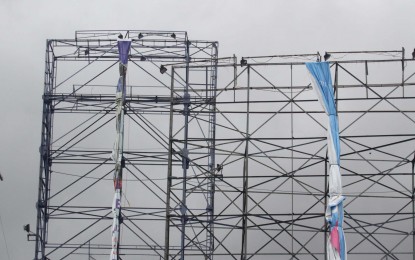
(File photo)
MANILA – President Rodrigo Roa Duterte has signed an executive order (EO) updating and supplementing the rules on non-mobile advertising signs and billboards.
Executive Order No. 165, signed by Duterte on March 21, covers all non-mobile advertising signs and billboards, and their support structures, erected and installed, modified, retrofitted, rehabilitated or otherwise altered, and exhibited.
In signing the EO, Duterte recognized that unregulated advertising signs and billboards pose traffic distractions and hazards, constitute threats to public safety and contribute to environmental degradation and urban blight due to their inappropriate location, site, glare, size, structural configuration and uncontrolled height limit.
"There is a need to update and supplement the rules on non-mobile advertising signs and billboards under the Building Code and its Implementing Rules and Regulations (IRR), and to prescribe minimum standards to harmonize national and local rules and regulations as part of the strategies on ease of doing business, and in facilitating self-regulation within the advertising industry," the EO read.
Under the EO, newly constructed billboard structures must have at least five meters of setback from the frontage property line, measured perpendicularly up to the support structure.
Existing static billboards or LED billboards with a setback of less than five meters must comply with the guidelines for size of display surface and height of billboard structures and relevant clearances from the high tension wire as prescribed in the Philippine Electrical Code.
The EO states that signs and sign structures and billboards must not exceed 250 square meters while LED and other electronic signs must have a minimum display area of 55 sqm. and a maximum display area of up to 250 sqm. as the site allows, provided that the sign conforms with structural design and wind load exposure prescribed under the latest edition of the National Structural Code of the Philippines.
As for the height of the billboard structures, free-standing structures must have a maximum height of 36 meters from the established grade, provided it will not obstruct any public utility and fire exits in accordance with existing laws.
A roof-mounted billboard structure must have a combined height limit of not more than 26 meters for urban areas and not more than 36 meters for rural areas, measured from the ground to the established grade.
New rooftop billboards must not exceed or occupy more than one-fourth of the street frontage of the building on which they are attached, with the base area of the support skeleton frame structure not more than 10 sqm. on any horizontal section, and must be constructed of incombustible material pursuant to Section 1210 of the Implementing Rules and Regulations (IRR) of the Building Code;
Wall-mounted billboards must be placed against blank walls and must not exceed the area of such wall, in accordance with the provisions of the latest revision of the IRR of the Building Code.
The EO also states that new billboard structures to be installed or erected at the same side of the road must have a minimum distance of 100 meters apart.
Obstruction of an existing billboard or on-premises sign by an advertising billboard from its intended viewership, no matter how partial, is strictly prohibited. The existing outdoor advertising sign is considered not obstructed by a newly constructed sign when it is fully visible within 200 meters distance from its intended audience.
Owners, operators given 2 years to comply
Within two years from the effectivity of this order, owners and operators of existing sign and billboard structures must comply with the foregoing standards on size of display surface and height of billboard.
All local governments must not impose requirements higher or more burdensome than the parameters provided to ensure uniformity and harmonization of national and local standards on signs and billboards.
The Department of Public Works and Highways (DPWH) must ensure full and strict enforcement of this order and may order payment of appropriate government fees and other charges for billboard permits and clearances.
The Department of Finance (DOF) must prepare guidelines for setting local fees and charges related to the application for locational clearances, provide training for local government personnel on the guidelines on fees, and increases of existing or prevailing costing of government charges; and assist in the compliance of local government units (LGUs) to the said guidelines and the preparation of regular reports to the Department of the Interior and Local Government (DILG) and the DPWH.
The DILG must assist the DPWH in ensuring compliance of LGUs with the provisions of the EO.
The DPWH, in consultation with the DILG, DOF, Metropolitan Manila Development Authority, Philippine Atmospheric, Geophysical and Astronomical Services Administration, Civil Aviation Authority of the Philippines, and representatives of stakeholders from the billboard industry, must formulate implementing guidelines to effectively carry out the provisions of this order.
Implementing guidelines must include, among others, the requirements and procedures for the issuance of the necessary permits for the erection, building, placement and installation of all outdoor advertising displays.
The non-issuance, suspension or revocation of building permits may be ordered in case of non-compliance with the provisions of this order, the Building Code and its IRR, or relevant administrative rule or regulation issued by the DPWH Secretary.
National or local officials and personnel who fail to comply with the provisions of this order must be proceeded against in accordance with civil service laws, rules and regulations, and relevant provisions of Republic Act 7160 or the Local Government Code of 1991. (PNA)
